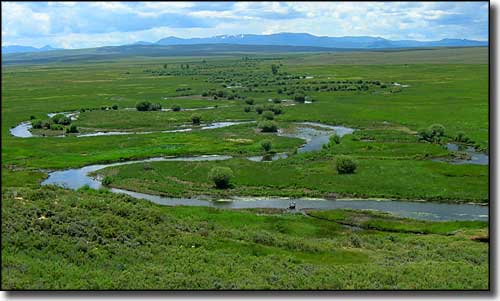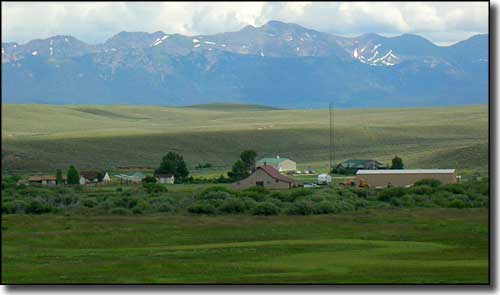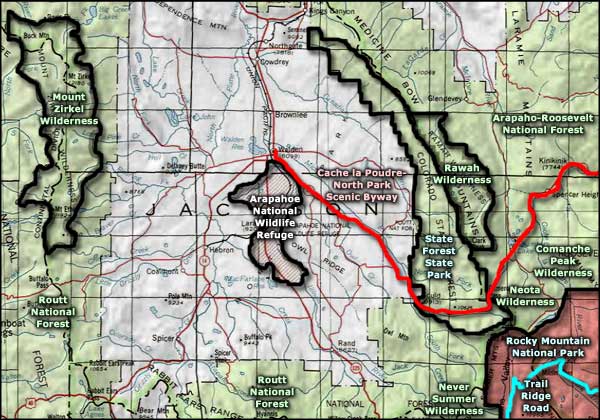
Arapaho National Wildlife Refuge

Arapaho National Wildlife Refuge
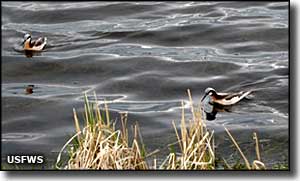
"The valley narrowed as we ascended and presently divided into a gorge, through which the river passed as through a gate - a beautiful circular valley of 30 miles in diameter, walled in all around with snowy mountains, rich with water and grass, fringed with pine on the mountain sides below the snow, and a paradise to all grazing animals."
John C. Fremont, 1844, from his journal of an expedition to California in advance of the Mexican-American War. One of his guides was Kit Carson, who had trapped and hunted in the area several times previously.
The Arapaho National Wildlife Refuge was established in 1967 in the center of North Park in Colorado to provide essential nesting habitat for migrating waterfowl. Successful management of the property requires the diversion of water from the Illinois River through a complex system of ditches and canals to fill brood ponds and irrigate wetland meadows. Various grazing systems and periodic burning are also used as means to improve the vegetative cover and vigor for nesting and brood rearing purposes. Water levels in the shallow ponds are manipulated to assure adequate supplies of aquatic vegetation for food and cover. The ponds also work to provide massive numbers of insects and other invertebrates needed by the waterfowl for successful breeding, and by their young for proper nourishment and growth after they've hatched.
Breeding season usually starts as soon as the ice has left the water surfaces. Canada geese start arriving in April, ducks really begin to arrive in May. The peak incoming migration season is late May. Duck nesting runs from early to late June and fall will usually see about 9,000 new ducklings take wing for their flight back south for the winter. Fall migration peaks in late September to early October.
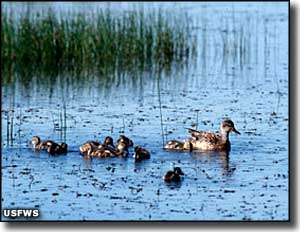
You'll find mallard, gadwall, pintail and American wigeon in the upland nesting areas. Diving ducks like the lesser scaup and redhead like the larger ponds and nearby wet meadows. You'll also find American avocet, Wilson's phalarope, sandpipers, willet, dowitchers and Greater yellowlegs in the wetlands. Sora and Virginia rails may be there, too, but they are shy birds and like to remain unseen. There may also be some American bittern, grebe, great blue heron and black-crowned night heron in the wetlands. There's usually more than 200 sage grouse in the upland hills all year round. And sometimes you might see golden eagles, prairie falcons and several species of hawks hunting from above.
Among the mammals you might find at Arapaho National Wildlife Refuge are mink, red fox, porcupine, red-tailed weasel, muskrat, badger, coyote, beaver, pronghorn antelope, mule deer and elk (in the winter months). Moose are also in the area but usually hang out in the willow thickets along the river bottom.
Public access is allowed and includes a 6-mile self-guided auto tour route from State Highway 14 that overlooks the Illinois River valley. Along the route you'll be able to learn more about the refuge and its wildlife and wildlife habitat. Other designated refuge roads are open for public use, too.
Fishing is allowed in some areas along the Illinois River, but some areas are signed as closed. Fishing can be hard because of the very dense willow thickets along the river. To minimize disturbance of nesting waterfowl, the refuge is closed to all fishing from June 1 through July 31. In season, the refuge is open for certain big game species. The refuge is for day-use only and fires are not allowed, ever.
The larger photos on this page were taken in mid-July. The previous winter had brought large amounts of snow but the summer was reasonably dry. Nothing big was burning but fire bans were on everywhere in Colorado. The thunderclouds didn't deliver any measurable amount of rain until I was well off to the south, climbing through the mountains on the way to Granby.
